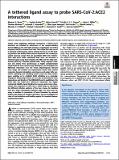Por favor, use este identificador para citar o enlazar a este item:
http://hdl.handle.net/10261/269456COMPARTIR / EXPORTAR:
 SHARE SHARE
 CORE
BASE CORE
BASE
|
|
| Visualizar otros formatos: MARC | Dublin Core | RDF | ORE | MODS | METS | DIDL | DATACITE | |

| Título: | A tethered ligand assay to probe SARS-CoV-2:ACE2 interactions |
Autor: | Bauer, Magnus Sebastian; Gruber, Sophia; Hausch, Adina; Gomes, Priscila S. F. C.; Milles, Lukas Frederik; Nicolaus, Thomas; Schendel, Leonard C.; López-Navajas, Pilar CSIC ; Procko, Erik; Lietha, Daniel CSIC ORCID ; Melo, Marcelo C. R.; Bernardi, Rafael C.; Gaub, Hermann Eduard; Lipfert, Jan | Palabras clave: | SARS-CoV-2 Host–pathogen interactions Force spectroscopy AFM Magnetic tweezers |
Fecha de publicación: | 21-mar-2022 | Editor: | National Academy of Sciences (U.S.) | Citación: | Proceedings of the National Academy of Sciences of the USA 119(14): e2114397119 (2022) | Resumen: | Severe acute respiratory syndrome coronavirus 2 (SARS-CoV-2) infections are initiated by attachment of the receptor-binding domain (RBD) on the viral Spike protein to angiotensin-converting enzyme-2 (ACE2) on human host cells. This critical first step occurs in dynamic environments, where external forces act on the binding partners and avidity effects play an important role, creating an urgent need for assays that can quantitate SARS-CoV-2 interactions with ACE2 under mechanical load. Here, we introduce a tethered ligand assay that comprises the RBD and the ACE2 ectodomain joined by a flexible peptide linker. Using magnetic tweezers and atomic force spectroscopy as highly complementary single-molecule force spectroscopy techniques, we investigate the RBD:ACE2 interaction over the whole physiologically relevant force range. We combine the experimental results with steered molecular dynamics simulations and observe and assign fully consistent unbinding and unfolding events across the three techniques, enabling us to establish ACE2 unfolding as a molecular fingerprint. Measuring at forces of 2 to 5 pN, we quantify the force dependence and kinetics of the RBD:ACE2 bond in equilibrium. We show that the SARS-CoV-2 RBD:ACE2 interaction has higher mechanical stability, larger binding free energy, and a lower dissociation rate compared to SARS-CoV-1, which helps to rationalize the different infection patterns of the two viruses. By studying how free ACE2 outcompetes tethered ACE2, we show that our assay is sensitive to prevention of bond formation by external binders. We expect our results to provide a way to investigate the roles of viral mutations and blocking agents for targeted pharmaceutical intervention. | Versión del editor: | https://doi.org/10.1073/pnas.2114397119 | URI: | http://hdl.handle.net/10261/269456 | DOI: | 10.1073/pnas.2114397119 | ISSN: | 0027-8424 | E-ISSN: | 1091-6490 |
| Aparece en las colecciones: | (PTI Salud Global) Colección Especial COVID-19 (CIB) Artículos |
Ficheros en este ítem:
| Fichero | Descripción | Tamaño | Formato | |
|---|---|---|---|---|
| pnas.2114397119.pdf | 4,27 MB | Adobe PDF |  Visualizar/Abrir |
CORE Recommender
SCOPUSTM
Citations
25
checked on 03-abr-2024
WEB OF SCIENCETM
Citations
22
checked on 23-feb-2024
Page view(s)
37
checked on 19-abr-2024
Download(s)
40
checked on 19-abr-2024
Google ScholarTM
Check
Altmetric
Altmetric
Este item está licenciado bajo una Licencia Creative Commons

